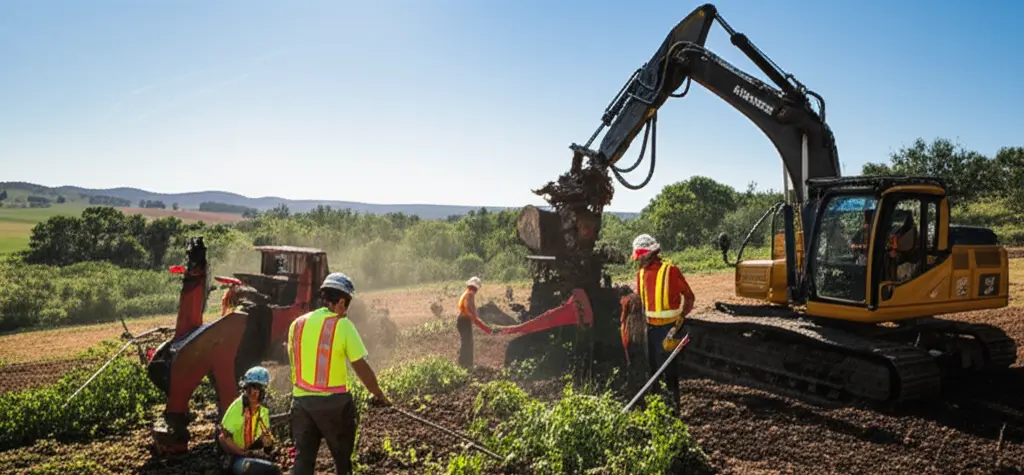




One of the most frequent local SEO mistakes land clearing companies encounter is vague or overly broad service area settings in their Google Business Profile (GBP). Unlike retail stores with a fixed location, land clearing businesses typically operate across multiple counties or regions. Google relies on service area radius data to determine when your business is relevant for a nearby search query, such as “land clearing near me.”
If your service area is undefined or too broad, Google’s algorithm might dilute your visibility. Instead of showing your profile in the top 3 local pack results, your business might get buried by competitors who specify a more precise and verifiable radius.
To correct this, focus on precision. If your equipment and crews generally work within a 50-mile range from your office, set that explicitly in GBP. Break it down further by specifying key cities or towns you actually serve. For example, rather than listing “Texas,” define your service areas as “Austin, Round Rock, Georgetown, and Bastrop.” This not only helps search engines align your business with user intent but also increases local trust as customers see their exact town listed.
A well-configured GBP service area often correlates with higher local rankings and more qualified leads because Google prioritizes businesses with accurate geographical relevance.
Land clearing demand is highly seasonal. Brush clearing may be in peak demand during summer and early fall due to fire prevention regulations, whereas excavation and site prep work spikes during off-seasons when construction starts. Ignoring this cycle is a major land clearing SEO error that reduces your visibility during critical search swings.
If your business only promotes general services year-round, you miss specific opportunities such as “winter construction site prep” or “spring brush removal.” These high-intent seasonal searches can attract customers who are ready to book immediately.
A strong solution is to develop a content calendar revolving around these cycles. Highlight brush management services between March and October, while emphasizing excavation and grading from late fall through early spring. Align blog posts, social media updates, and GBP posts around these seasonal service peaks. A Florida-based land clearing contractor who implemented seasonal landing pages saw a 38% increase in organic leads over six months because searchers could quickly find time-relevant services.
By proactively publishing timely and location-targeted seasonal content, you can maintain consistent visibility across all 12 months—transforming traditional slow seasons into lead-generating opportunities.
Another common mistake is overlooking the influence of project photos. For land clearing companies, visuals can dramatically increase customer engagement by showing the before-and-after transformation of a property. According to BrightLocal, businesses with at least 100 photos on GBP receive 520% more calls than those with fewer images.
Unfortunately, many land clearing websites and profiles use either generic stock imagery or minimal visuals that fail to demonstrate credibility. This weakens local SEO performance since both users and Google value strong visual signals.
To optimize, upload authentic project photos showcasing different services: forest mulching, full-site clearing, and grading. Add keyword-rich file names and descriptive alt text, such as “forestry mulching project in [city]” or “lot clearing near [neighborhood name].” Tools also allow geo-tagging images with coordinates, reinforcing your connection to specific service areas.
A land clearing business in North Carolina began uploading at least five project photos per job, optimized with metadata. Within five months, their Google Maps listing saw a 60% rise in direction requests and 25% growth in lead calls.
Visual trust drives client confidence. When local customers can see equipment in action and the scope of your projects, they’re more likely to choose your business over competitors.
Keyword targeting is foundational to local SEO, but many contractors mistakenly optimize around generic words like “land services” or “tree work.” While these drive volume, they rarely attract high-quality local leads. The real power comes from industry-specific, localized keyword strategies.
Broad terms such as “land clearing” attract both residential and commercial searchers across states. But when searchers use phrases like “forestry mulching near me” or “residential land clearing in Dallas,” they reveal stronger intent to hire immediately. By ignoring these niche phrases, land clearing companies miss high-value conversions.
The solution is structured keyword research. Identify 10-15 service-based keywords tied to specific locations, such as “lot clearing for new builds in [city]” or “driveway site prep [town].” Incorporate these into service pages, meta descriptions, and GBP updates. Service pages will increase dramatically when your digital presence directly mirrors terms customers type into search engines.
Instead of chasing generic rankings, niche keyword targeting ensures that the leads you generate are qualified, local, and more likely to convert—efficiency that most generic SEO strategies can’t provide.
Citation management is one of the most underutilized aspects of local SEO for contractors. Local citations represent online mentions of your business across directories, social platforms, and association websites. Consistency of NAP data (Name, Address, Phone) is essential. Unfortunately, land clearing companies often update phone numbers or expand service locations without syncing this across all platforms, leading to local citation errors.
Inconsistent citations confuse both potential customers and Google’s algorithm. A Moz study revealed citation inaccuracies are among the top five negative local ranking factors.
To maintain consistency, use platforms such as Whitespark, BrightLocal, or Yext to audit and update citations. Ensure your business name matches exactly across Google, Yelp, Houzz, and industry directories such as HomeAdvisor. A Midwest land clearing contractor used citation cleanup tools and saw a 22% bump in Google Maps visibility in two months.
Citations essentially act as reputation signals. The more consistent they are, the more authority your local listing builds.
Schema markup—a structured data code added to your site’s backend—tells search engines specific details about your business, like services, locations, and customer ratings. Many land clearing websites lack this, resulting in inefficient communication with Google.
Local Business Schema allows Google to display enhanced search snippets, including service categories, operating hours, and customer reviews directly in results. This improves click-through rates and builds credibility with users before they even visit your site.
Implementing schema doesn’t require advanced coding. Plugins like Yoast or Rank Math simplify the process. Adding LocalBusiness and Service schema to your site can result in rich snippets like “Forestry Mulching Contractor in [city], Hours: 7am–7pm.” Contractors that implement schema often see a 10–15% increase in organic click-through rates.
By skipping schema, you handicap your online presence. By incorporating it, you simplify both how Google and potential clients interpret your services.
Today, over 60% of local searches happen on mobile. If your website isn’t responsive, potential leads will bounce before contacting you. Many land clearing business sites have outdated designs, slow load speeds, or PDFs of service details instead of mobile-optimized pages. This creates unnecessary friction in the user journey.
A mobile-friendly design means short load times (under 3 seconds), click-to-call buttons, simplified menus, and service information accessible without pinching or zooming. Google also prioritizes mobile usability in its ranking algorithm, meaning poor mobile performance can directly sink your visibility.
Simple fixes include upgrading to a responsive WordPress theme, compressing large project images, and using Google’s Mobile-Friendly Test to identify issues. Data shows that businesses optimizing mobile experience reduce bounce rates by up to 40% and significantly increase lead submissions.
Service area pages remain one of the strongest tools to rank in multiple local markets. Rather than lumping all services on a single page, create localized content for each target city. For instance, “Brush Clearing in Tulsa” and “Site Preparation Services in Broken Arrow.”
Balance broad service information with hyper-local details, such as recent project photos, client testimonials from that city, or references to local regulations (e.g., burn permits or erosion control). This helps search engines connect your business to multiple localities without keyword stuffing.
A contractor in Georgia created 12 hyper-local city pages and reported a 300% increase in calls from surrounding counties within six months. Detailed content that proves local relevance directly drives these results.
GBP is a living platform, not a one-time setup. Many local businesses make the mistake of updating it once, then ignoring it. In competitive local industries like land clearing, fresh updates strongly influence ranking.
Regular updates include verifying phone numbers, adjusting service hours, and highlighting seasonal offerings. Adding new photos, responding to Q&A, and posting about recent projects signals to Google that your business is active and engaged. Studies show profiles with weekly updates receive 2x more engagement than stagnant ones.
For land clearing companies, this could mean posting regular updates about completed jobs, showcasing equipment, or sharing safety tips during brush fire season. Doing so helps strengthen brand visibility while making your GBP listing more appealing to potential leads.
Reviews are one of the strongest local search ranking signals, accounting for nearly 20% of local pack visibility. Yet, many contractors fail to establish a system for generating and responding to reviews.
A land clearing business with just five reviews can seem less trustworthy than a competitor with 35+ reviews averaging 4.7 stars. Beyond rankings, reviews heavily influence customer trust. BrightLocal reports that 77% of consumers always read reviews before hiring a local service.
Strategies include asking for reviews after successful jobs via SMS or email. Always respond to reviews—both positive and negative—to show credibility. Tools like Podium or Broadly can automate outreach while keeping it professional.
One Texas-based excavating and land clearing firm implemented an automated follow-up review request system. In a year, they grew from 9 reviews to 95, which raised their profile into the top 3 Google Maps spots in most of their service cities.
By applying these strategies and avoiding costly SEO mistakes, land clearing businesses can strengthen their digital footprint, steadily generate qualified leads, and outpace competitors in regional search results.
